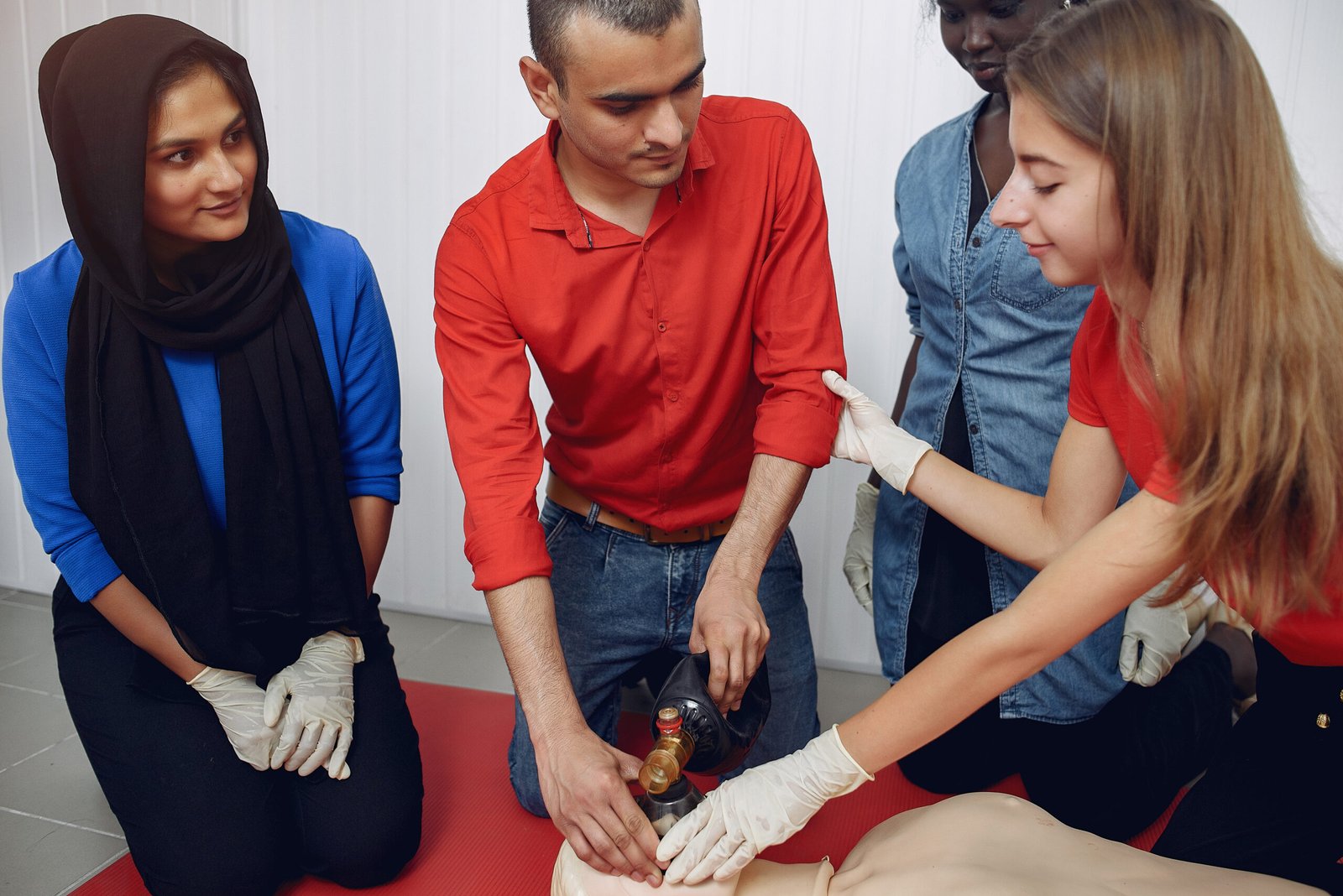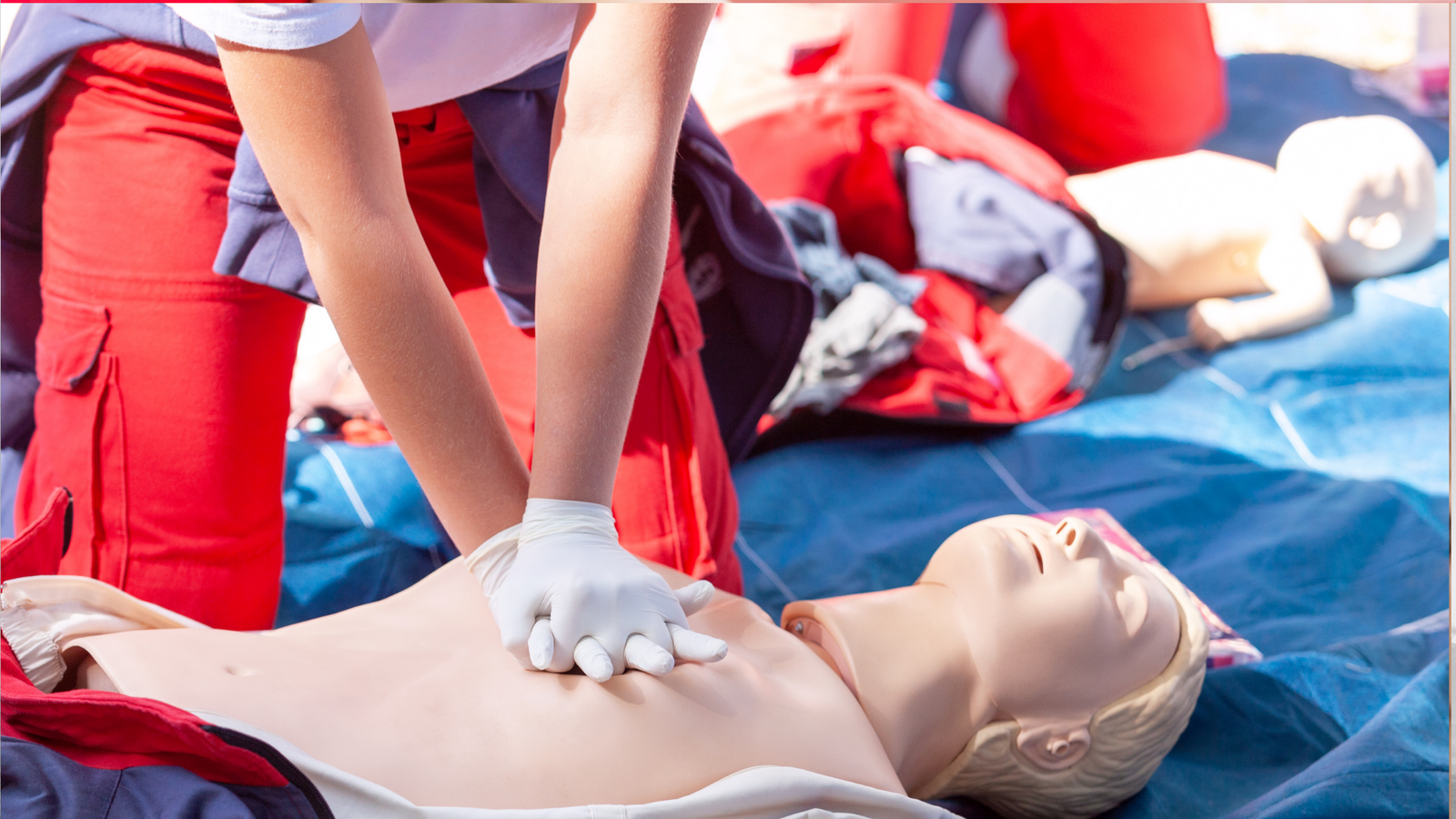Community groups in Australia often involve people from various backgrounds, ages, and health conditions. Whether you’re running a local sports club, volunteering at a community center, or managing a neighborhood event, first aid training is crucial for ensuring everyone’s safety. In this blog, we’ll explore the importance of first aid training for community groups and how AB First Aid Training can help prepare your team. 1. Creating a Safe Environment for Everyone The Concern: Community events or group activities can lead to injuries, especially when many people are involved.The Solution: First aid training ensures that everyone involved in community events is prepared to handle injuries and emergencies. Whether it’s a minor injury or a serious accident, trained responders can step in to provide immediate care. 2. Ensuring Safety During Outdoor Activities The Concern: Many community groups participate in outdoor activities, such as hiking, sports, or festivals, where accidents are more likely.The Solution: First aid training prepares volunteers to handle outdoor-specific injuries, such as heat exhaustion, dehydration, or fractures. By having trained individuals on-site, you can reduce the risk of severe consequences and create a safer atmosphere for participants. 3. Managing Medical Conditions in a Group Setting The Concern: Community groups often include people with pre-existing medical conditions, such as asthma, diabetes, or allergies.The Solution: First aid training teaches you how to recognize and manage conditions like asthma attacks, diabetic emergencies, and allergic reactions. Having a trained team means that participants with medical conditions can enjoy activities with peace of mind, knowing that help is readily available. 4. Building Trust Within the Community The Concern: A lack of preparedness can lead to fear or hesitation during emergencies.The Solution: First aid training builds trust by showing that your community group is responsible and ready to handle emergencies effectively. This trust encourages participation and engagement in your programs and activities, knowing everyone’s safety is a priority. 5. Improving Emergency Preparedness for All Activities The Concern: Unpreparedness in emergencies can lead to serious outcomes.The Solution: First aid training ensures that your community group is ready for any situation. By creating clear emergency response protocols, your team can handle situations more efficiently. This preparedness enhances the safety of all involved and reduces the risk of accidents spiraling out of control. Conclusion First aid training for community groups is essential to ensure the safety and well-being of all participants. It’s a smart investment that protects everyone and fosters a stronger, more engaged community. Questions for Reflection: How prepared is your community group for medical emergencies? What steps can you take today to improve your group’s first aid readiness?
First Aid Training for Schools: Why Every Teacher Should Be Trained
Teachers are more than just educators—they are also responsible for the safety and well-being of their students. Accidents and medical emergencies can occur at any time in the classroom, playground, or school bus. That’s why it’s essential for teachers to have first aid training. At AB First Aid Training, we offer tailored courses for educators, ensuring they can provide the necessary care when it matters most. 1. Responding to Classroom Emergencies The Concern: Injuries like cuts, burns, or allergic reactions often happen in the classroom.The Solution: First aid training ensures that teachers are prepared to handle these incidents swiftly and competently. With the right knowledge, teachers can stabilize students until professional medical help arrives. 2. Handling Medical Emergencies in the Playground The Concern: Playground accidents, such as broken bones or head injuries, are common.The Solution: First aid training helps teachers manage these situations by providing first response care, including splinting, wound dressing, and CPR if necessary. By acting quickly, teachers can prevent further harm and ensure the student receives the proper care. 3. Managing Allergic Reactions and Asthma Attacks The Concern: Allergic reactions and asthma attacks can be life-threatening if not treated immediately.The Solution: Teachers trained in first aid can quickly identify symptoms of anaphylaxis or asthma and know how to administer medications like epinephrine or inhalers. With training, teachers can save lives in critical moments, giving students the best chance for recovery. 4. Dealing with Seizures and Unconscious Students The Concern: Seizures or unconsciousness can happen unexpectedly, especially in younger students.The Solution: First aid training teaches teachers how to manage seizures, position students safely, and monitor their condition until help arrives. In emergencies like this, every second counts, and training ensures teachers know what to do. 5. Ensuring Legal Compliance and Duty of Care The Concern: Teachers have a legal obligation to ensure students’ safety.The Solution: First aid training is essential for meeting legal requirements and fulfilling the duty of care to students. By completing a first aid course, teachers not only enhance their ability to respond to emergencies but also ensure compliance with regulations. Conclusion Teachers are the first line of defense when accidents or medical emergencies happen in schools. With first aid training, they are prepared to protect their students and create a safer learning environment. Questions for Reflection: Does your school have enough trained first aid responders for all classrooms? How can your school improve emergency preparedness for students and staff? Book your teacher training with AB First Aid Training at www.abfirstaid.com.au or call 03 8364 8984 for more information. Sources: Department of Education – First Aid for Schools Royal Children’s Hospital – Managing School Emergencies Australian Red Cross – First Aid for Teachers
Why First Aid Training is Essential for Australian Sports Teams
Sports injuries are a common part of athletic activities, whether you’re playing professionally or as an amateur. In Australia, where outdoor sports are a big part of life, first aid knowledge is essential for coaches, players, and team managers. At AB First Aid Training, we provide tailored courses for sports teams to ensure they are equipped to handle any injury, big or small. In this blog, we’ll explore why first aid training should be a priority for sports teams. 1. Handling Common Sports Injuries The Concern: Sprains, strains, fractures, and cuts are frequent in sports.The Solution: First aid training gives coaches and players the tools to manage common injuries effectively. From RICE (Rest, Ice, Compression, Elevation) techniques to bandaging and splinting, AB First Aid Training covers everything sports teams need to know. 2. Recognizing and Managing Concussions The Concern: Concussions can be life-threatening and require immediate attention.The Solution: First aid training equips you with the skills to recognize concussion symptoms and provide immediate care. This knowledge is crucial for coaches and team medical staff to prevent further injury and get the player proper medical attention. 3. Reducing the Risk of Severe Injuries The Concern: Sports injuries can escalate quickly without proper care.The Solution: Early intervention, such as performing CPR or controlling severe bleeding, can significantly improve recovery chances. First aid training ensures that your team is prepared for emergencies, minimizing the risk of long-term damage. 4. Teaching Players to Prevent Injuries The Concern: Prevention is better than cure, especially with recurring sports injuries.The Solution: First aid training also includes injury prevention strategies, such as warm-ups, proper stretching, and hydration techniques. By teaching your team first aid and safety protocols, you help them avoid injuries and stay in top condition for the game. 5. Creating a Safe Team Environment The Concern: The safety of all players, staff, and fans should always come first.The Solution: Having a first aid-trained coach or team manager means everyone feels safe, knowing someone can respond to emergencies immediately. This fosters a supportive, responsible atmosphere where everyone can focus on performance with confidence. Conclusion First aid training is not just for hospitals or home care—it’s vital for sports teams too. It ensures that injuries are managed effectively, and lives are saved. With the right training, you can be ready for anything that comes your way. Questions for Reflection: Does your sports team have first aid-trained staff on hand during training and games? What steps can your team take today to improve its emergency preparedness? Want to be prepared for any sports-related emergency? Book your sports team’s first aid course with AB First Aid Training at www.abfirstaid.com.au or call 03 8364 8984 for more details. Sources: Australian Sports Commission – First Aid for Coaches Royal Children’s Hospital Melbourne – Sports Injury Prevention Australian Red Cross – Sports First Aid
How First Aid Training Can Benefit Your Workplace
Workplace accidents are more common than we often think, and every workplace—whether it’s an office, factory, or construction site—needs employees who are trained to respond to emergencies. First aid training not only helps save lives but also boosts morale and productivity in the workplace. In this blog, we’ll discuss the key benefits of first aid training for employees and employers alike and how AB First Aid Training can help create a safer work environment. 1. Boosting Workplace Safety The Concern: Accidents and injuries are part of many jobs, especially in high-risk industries like construction, manufacturing, and healthcare.The Solution: Having trained first aid responders on site reduces the severity of injuries and ensures that employees receive immediate care. AB First Aid Training provides workplace-specific training courses tailored to your industry, ensuring your team is equipped to handle anything. 2. Increasing Employee Confidence and Morale The Concern: Employees may feel anxious or unprepared in an emergency situation.The Solution: First aid training boosts confidence by giving employees the knowledge they need to react quickly and efficiently in a crisis. Knowing they are trained to handle emergencies creates a sense of security, fostering a more positive and productive work environment. 3. Ensuring Compliance with Health and Safety Regulations The Concern: Workplaces have a legal obligation to ensure the health and safety of their employees.The Solution: First aid training ensures that your business complies with Occupational Health and Safety (OHS) requirements, minimizing risk and ensuring a safe environment for everyone. AB First Aid Training offers accredited courses that meet workplace health and safety standards, making it easy to stay compliant. 4. Reducing Emergency Response Time The Concern: Delayed responses can worsen the outcomes of workplace injuries.The Solution: Having first aid-trained employees on hand means that injuries can be treated immediately, minimizing the severity of accidents and reducing recovery time. When your team is ready to act, emergencies are handled swiftly and effectively, preventing further complications. 5. Providing Lifesaving Skills During Critical Moments The Concern: In life-threatening situations, minutes matter.The Solution: First aid training equips employees with the skills needed to perform CPR, use defibrillators, and manage severe bleeding. The ability to act quickly and decisively can save lives—whether it’s an employee, client, or visitor to your workplace. Conclusion Investing in first aid training benefits your team and your business. Not only does it save lives, but it also boosts morale, ensures compliance, and reduces workplace risks. Don’t wait for an emergency to highlight the need—book your workplace training today. Questions for Reflection: Does your workplace have a trained first aider on-site? What other safety measures could you implement to ensure your workplace is as safe as possible? Ready to create a safer workplace? Book your first aid training with AB First Aid Training at www.abfirstaid.com.au or call 03 8364 8984 for more details. Sources: Safe Work Australia – Workplace Health and Safety WorkSafe Victoria – First Aid in the Workplace Australian Red Cross – Workplace First Aid
Why First Aid Training is Essential for Australian Parents
In life’s unpredictable moments, every second matters. Whether at home, work, or in public spaces, having the knowledge of fast and effective first aid practices can be the difference between a close call and a crisis averted. At AB First Aid Training, we believe in empowering individuals with the skills needed to act decisively in emergencies. In this blog post, we’ll explore some key first aid practices that can make a significant impact when time is of the essence. Rapid Response Techniques Immediate Assessment: Learn to assess the situation quickly and prioritise actions based on the victim’s condition. AB First Aid Training emphasises the importance of staying calm and focused in high-pressure situations. Effective CPR: Learn to assess the situation quickly and prioritise actions based on the victim’s condition. AB First Aid Training emphasises the importance of staying calm and focused in high-pressure situations. Book your CPR course now Swift Wound Care: Know how to clean and dress wounds promptly to prevent infections. AB First Aid Training provides hands-on training to enhance your wound care skills. Explore our wound care courses Addressing Common Emergencies Choking Incidents: Learn the Heimlich maneuver to dislodge objects from the airway. AB First Aid Training guides you through practical scenarios to build your confidence in responding to choking incidents. Seizures: Understand the appropriate steps to ensure the safety of the person experiencing a seizure. Our courses provide insights into recognizing different types of seizures and offering timely assistance. Conclusion: In the face of emergencies, being equipped with fast and effective first aid practices can make you a real-life hero. AB First Aid Training is dedicated to providing you with the skills and knowledge needed to act decisively when it matters most. Now, ask yourself – are you prepared to be someone’s lifeline? Questions for Reflection: How confident do you feel in your ability to respond swiftly in a first aid emergency? Have you ever been in a situation where fast first aid knowledge would have made a significant difference? Sources: Australian Resuscitation Council. (www.resus.org.au) St John Ambulance Australia. (www.stjohn.org.au) HealthDirect Australia. (www.healthdirect.gov.au) AB First Aid Training: Book your CPR course now | Call us at 03 8364 8984.
The Top 5 First Aid Mistakes and How to Avoid Them
When emergencies happen, even the best intentions can lead to mistakes if you’re not properly trained. First aid isn’t just about action—it’s about the right action. At AB First Aid Training, we teach you the practical skills to handle emergencies confidently and correctly. In this blog, we’ll uncover the most common first aid mistakes Australians make and how you can avoid them. 1. Delaying CPR or Defibrillation The Mistake: Waiting for medical professionals instead of starting CPR immediately.Why It’s Critical: Every minute without CPR reduces the survival rate of cardiac arrest victims by 10%. At AB First Aid Training, we guide you through CPR techniques and how to use a defibrillator so you can act immediately. 2. Incorrectly Treating Burns The Mistake: Applying ice, butter, or creams to burns.The Right Way: Cool the burn under running water for at least 20 minutes and cover it with a non-stick dressing. Our courses include modules on treating burns and other common injuries correctly, ensuring you can respond safely. 3. Not Checking for Danger First The Mistake: Rushing to help without assessing the situation.The Right Way: Follow the DRSABCD approach: Check for Danger. Assess the Response of the patient. This ensures your safety while providing help. 4. Moving Someone with a Suspected Spinal Injury The Mistake: Moving an injured person too soon, potentially worsening their condition.The Right Way: Keep the person still and provide reassurance until emergency services arrive. Our first aid courses cover handling spinal injuries to minimise further harm. 5. Failing to Control Bleeding Properly The Mistake: Using a makeshift tourniquet or not applying enough pressure.The Right Way: Use a clean cloth to apply firm, steady pressure until help arrives. At AB First Aid Training, we teach bleeding control techniques that save lives in critical situations. Conclusion Mistakes in first aid can have serious consequences, but with the right training, you can avoid them and provide effective care. Don’t let uncertainty hold you back—invest in life-saving skills today. Questions for Reflection: Do you feel confident about handling a medical emergency without making these mistakes? How often do you refresh your first aid skills to stay prepared? Take action now! Book a first aid course with AB First Aid Training at www.abfirstaid.com.au or call 03 8364 8984 to ensure you’re ready for any situation. Sources St John Ambulance Australia – First Aid Myths and Facts Healthdirect Australia – First Aid for Burns Australian Government Department of Health – CPR Guidelines
When Every Second Counts: Fast and Effective First Aid Practices
In life’s unpredictable moments, every second matters. Whether at home, work, or in public spaces, having the knowledge of fast and effective first aid practices can be the difference between a close call and a crisis averted. At AB First Aid Training, we believe in empowering individuals with the skills needed to act decisively in emergencies. In this blog post, we’ll explore some key first aid practices that can make a significant impact when time is of the essence. Rapid Response Techniques Immediate Assessment: Learn to assess the situation quickly and prioritise actions based on the victim’s condition. AB First Aid Training emphasises the importance of staying calm and focused in high-pressure situations. Effective CPR: Learn to assess the situation quickly and prioritise actions based on the victim’s condition. AB First Aid Training emphasises the importance of staying calm and focused in high-pressure situations. Book your CPR course now Swift Wound Care: Know how to clean and dress wounds promptly to prevent infections. AB First Aid Training provides hands-on training to enhance your wound care skills. Explore our wound care courses Addressing Common Emergencies Choking Incidents: Learn the Heimlich maneuver to dislodge objects from the airway. AB First Aid Training guides you through practical scenarios to build your confidence in responding to choking incidents. Seizures: Understand the appropriate steps to ensure the safety of the person experiencing a seizure. Our courses provide insights into recognizing different types of seizures and offering timely assistance. Conclusion: In the face of emergencies, being equipped with fast and effective first aid practices can make you a real-life hero. AB First Aid Training is dedicated to providing you with the skills and knowledge needed to act decisively when it matters most. Now, ask yourself – are you prepared to be someone’s lifeline? Questions for Reflection: How confident do you feel in your ability to respond swiftly in a first aid emergency? Have you ever been in a situation where fast first aid knowledge would have made a significant difference? Sources: Australian Resuscitation Council. (www.resus.org.au) St John Ambulance Australia. (www.stjohn.org.au) HealthDirect Australia. (www.healthdirect.gov.au) AB First Aid Training: Book your CPR course now | Call us at 03 8364 8984.
Turning Up the Heat: Mastering First Aid for Thermal Injuries with AB First Aid Training
Welcome to the scorching world of first aid mastery! In this blog post, we’ll explore the ins and outs of dealing with burns, providing you with essential skills to handle thermal injuries confidently. With AB First Aid Training as your guide, you’ll not only discover effective burn care but also take the first step towards becoming a certified first aid expert. 1. Understanding Burns: Navigating the Heat Burns can happen anywhere, from the kitchen to the workplace. We’ll break down the different types of burns, from minor to severe, and unveil the secrets of effective first aid. AB First Aid Training’s expert instructors ensure you’re equipped with hands-on techniques to address thermal injuries promptly and with precision. Pro Tip: AB First Aid Training goes beyond theory. Experience practical burn care in their upcoming courses here and be prepared for any burn-related emergency. 2. First Aid Essentials: Cooling the Flames Learn the crucial steps to take in the first moments after a burn occurs, from cooling the affected area to applying appropriate dressings. Our guide highlights the importance of quick and effective burn care and how AB First Aid Training’s courses elevate your confidence in managing thermal injuries. Pro Tip: Ready to enhance your burn care skills? Check out AB First Aid Training’s advanced burn care workshops here. 3. Prevention is Key: A Safer Approach to Daily Activities Explore practical tips from AB First Aid Training on preventing burns in everyday scenarios. From kitchen safety to workplace precautions, we’ll empower you with knowledge that not only keeps you safe but also positions you as a proactive advocate for burn prevention. Pro Tip: Join AB First Aid Training’s community of safety-conscious individuals. Book your course now and contribute to a safer environment. Conclusion: Congratulations, you’ve now mastered the art of dealing with burns! With AB First Aid Training, you’re not just learning first aid; you’re gaining practical skills that can make a real difference. Share your newfound knowledge and inspire others to take the plunge into first aid expertise. What burn care tip resonated with you the most, and how do you plan to incorporate it into your daily life? Share your thoughts below and let’s build a community of burn care champions! Sources: Australian Government – HealthDirect. “Burns and Scalds.” Better Health Channel. “Burns and Scalds – First Aid.” Burns Registry of Australia and New Zealand. “Preventing Burns.” AB First Aid Training. “Upcoming Burn Care Workshops.” AB First Aid Training. “Book Your First Aid Course Now.”
The Essential Guide to First Aid: Be Prepared for Any Emergency
In a world where emergencies can happen at any time, being equipped with the knowledge of first aid is not just a skill; it’s a lifesaver. At AB First Aid Training, we believe that everyone should have access to this crucial knowledge. In this comprehensive guide, we’ll explore the fundamental principles of first aid, empowering you to respond effectively in any emergency situation. 1. Understanding the Basics of First Aid Start by understanding the ABCs of first aid: Airway, Breathing, and Circulation. Learn to assess the scene and ensure it’s safe for you and others. Identify common emergencies and the immediate actions to take. 2. Building Your First Aid Kit Explore the essential items every first aid kit should contain. Tips for customizing your kit based on your specific needs. Maintaining and regularly updating your first aid supplies. 3. CPR Demystified: A Life-Saving Skill Break down the steps of Cardiopulmonary Resuscitation (CPR). Highlight the importance of quick and effective CPR in saving lives. Practical tips for performing CPR confidently. 4. Dealing with Common Injuries and Illnesses Addressing cuts, burns, and fractures with basic first aid techniques. Recognizing signs of heart attacks, strokes, and allergic reactions. The role of first aid in stabilizing a person’s condition until professional help arrives. 5. First Aid for Children and Infants Tailoring first aid techniques for the unique needs of young ones. Handling common childhood emergencies with confidence. Tips for childproofing your environment Conclusion: In conclusion, being prepared for emergencies is not just a choice but a responsibility we owe to ourselves and those around us. AB First Aid Training is here to guide you through this essential knowledge, ensuring you’re equipped to handle any situation life throws at you. Whether you’re a parent, caregiver, or just someone who wants to make a difference, taking a first aid course with AB First Aid Training can be your first step towards a safer community. Questions for Reflection: Have you ever found yourself in a situation where knowing first aid could have made a difference? What steps can you take today to ensure you’re prepared for emergencies in your daily life? Sources: St John Ambulance Australia. “Basic Life Support.” Australian Red Cross. “First Aid Kit Essentials.” Better Health Channel, Victoria. “Cardiopulmonary Resuscitation (CPR).” HealthDirect Australia. “First Aid for Burns.” Raising Children Network. “Child First Aid.” For more in-depth knowledge and hands-on training, book your first aid course with AB First Aid Training at www.abfirstaid.com.au or call us at 03 8364 8984. Your safety is our priority.
Stay Afloat: Drowning Prevention and Water Safety First Aid
Australia’s beautiful beaches, rivers, and pools beckon us to enjoy the water, but it’s essential to be aware of potential risks. AB First Aid Training is here to dive into the crucial topic of drowning prevention and water safety first aid, ensuring your aquatic adventures remain enjoyable and safe. Dive In Safely: A Deep Dive into Drowning Prevention Understanding the Risks: Explore the statistics and common scenarios leading to drownings. AB First Aid Training emphasizes the importance of awareness to prevent water-related emergencies. Water Safety Measures Dive into practical tips for ensuring safety in and around water. From supervising children to using life jackets, we’ll guide you through preventive measures that could make a significant difference. Recognizing Signs of Drowning: Discover the subtle signs of drowning that may not match the dramatic portrayals in media. AB First Aid Training provides insights into identifying distress, allowing for swift and effective responses. Immediate First Aid for Drowning Incidents: Learn the ABCs of water rescue – Assess, Be Safe, and Commence Rescue. Our courses offer hands-on training to equip you with the skills needed to assist someone in a drowning emergency. Conclusion: In the vast blue expanse, safety is paramount. AB First Aid Training is dedicated to ensuring you have the knowledge and skills to enjoy water activities responsibly. Ready to make a splash in water safety? Book a course with AB First Aid Training today. Call us at 03 8364 8984 or visit www.abfirstaid.com.au to secure your spot. What water safety practices do you follow, and how do you ensure the safety of yourself and others in aquatic environments? Share your tips below and let’s create a safer water culture together. Sources: Royal Life Saving Society Australia. (www.royallifesaving.com.au) Australian Water Safety Council. (www.watersafety.com.au) Surf Life Saving Australia. (www.slsa.com.au) Better Health Channel – Victoria State Government. (www.betterhealth.vic.gov.au)




